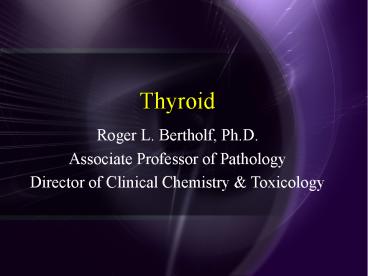Thyroid - PowerPoint PPT Presentation
Title:
Thyroid
Description:
Thyroid Roger L. Bertholf, Ph.D. Associate Professor of Pathology Director of Clinical Chemistry & Toxicology Thyroid hormones Effects of thyroid hormones Calorigenic ... – PowerPoint PPT presentation
Number of Views:125
Avg rating:3.0/5.0
Title: Thyroid
1
Thyroid
- Roger L. Bertholf, Ph.D.
- Associate Professor of Pathology
- Director of Clinical Chemistry Toxicology
2
Thyroid hormones
Tetraiodothyronine (T4, Thyroxine)
3,5,3 Triiodothyronine (T3)
3,3,5 Triiodothyronine (reverse T3)
3
Effects of thyroid hormones
- Calorigenic (? O2 consumption)
- Growth, development, sexual maturation, CNS
maturation - ? HR and contraction
- ? Protein synthesis, C(H2O)n metabolism, lipid
turnover - ? Sensitivity of ?-adrenergic receptors to
catecholamines - Brain, retina, lungs, spleen, testes appear to be
unaffected by thyroid hormones
4
Regulation of thyroid hormones
TRH
TSH
T4 (T3)
T3 (rT3)
5
Thyroid hormone production
Colloid
Follicle
TPO
Iodide (I-)
NIS
I-
(40X)
Thyroglobulin
TSH
Sodium/Iodide Symporter protein
6
Thyroid hormone synthesis
Thyroglobulin
Free thyroxine
7
Peripheral T4 metabolism
8
Peripheral thyroxine metabolism
- T4 production is exclusively thyroidal
- 70-90 of T3 is produced extrathyroidally
- 95-98 of rT3 is produced extrathyroidally
- Most peripheral de-iodination occurs in the liver
- T3 accounts for most of the thyroid hormone
activity in peripheral tissues - 3-4 times more potent than T4
- Some researchers have questioned whether T4 has
any intrinsic biological activity - rT3 is biologically inactive
9
Circulating thyroid hormones
99.97 T4
fT4 (0.03) fT3 (0. 3)
Only free hormone is active!
99.7 T3
10
Affinities of thyroid binding proteins
TBG
Alb
TBPA
gtgtgt
gtgt
68 of T4 80 of T3 Low conc. (0.27 ?M) High
affinity (K1010) 54 kDa
20 of T4 11 of T3 High conc. (640 ?M) Low
affinity (K105) 66 kDa
11 of T4 9 of T3 Low conc. (4.6 ?M) Low
affinity (K107) 15.5 kDa
A small fraction of thyroid hormones is bound to
lipoproteins
11
Increased protein binding
- ? TBG
- Genetic, NTI (HIV, hepatitis, estrogen-producing
tumors, AIP), pregnancy, drugs - ? Prealbumin (TBPA) (euthyroid thyroxine excess)
- Albumin variant (familial dysalbuminemia
hyperthyroxinemia) - T4 autoantibodies
12
Decreased protein binding
- ? TBG
- Genetic, NTI (NS), drugs, nephrosis
- ? Prealbumin (TBPA)
- ? TBG binding capacity (competing drugs such as
salicylate and phenytoin)
13
Thyroglobulin (Tg)
- 660 kd protein that is the intra-thyroidal
carrier of thyroid hormones - Synthesized in the thyroid follicular cells
secreted into the lumen - Stored mostly in the colloid
- Synthesis, colloidal uptake, and proteolysis (to
release T4 and T3) regulated by TSH
14
Thyrotropin (TSH)
- One of several hormones synthesized in the
anterior pituitary - Others are LH, FSH, Prolactin, ACTH, GH
- ? (common with LH, FSH, hCG) and ? subunits
- MW30 kDa
- Binds to a TSH receptor on the thyroid follicular
cells to activate adenylyl cyclase/cAMP protein
kinase A and Ca protein kinase C pathways
15
Sick Euthyroid
Healthy
Sick
T3
T3
Peripheral T4
rT3
rT3
16
Sick Euthyroid
rT3
TSH
Normal range
fT4
Concentration ?
T4
T3
Mild
Moderate
Severe
Recovery
Phase of illness
17
Hypothyroidism
- A deficiency in thyroid hormone activity
- Occurrence as high as 15, with ?preference
- Myxedema is severe form
- Untreated congenital hypothyroidism results in
severe developmental deficits - Can be structural or functional
- 1 deficiency in thyroid hormone production
- 2 (or central) pituitary or hypothalamic
failure - Hypothalamic failure sometimes called 3
18
Primary Hypothyroidism
- Iodine deficiency (most common worldwide)
- Hashimotos thyroiditis (most common in developed
countries) - Autoimmune (a-TG or a-TPO)
- Non-goitrous causes
- Radioactive I2 therapy/exposure surgical
ablation - Congenital (1 per 3500 to 4000 live births)
19
Secondary Hypothyroidism
- Pituitary (TSH) or hypothalamic (TRH) failure.
- Isolated TSH deficiency is rare usually
associated with panhypopituitarism. - Sheehans Syndrome
- Endocrine-inactive adenomas
- Other space-occupying lesions
20
Stages of Hypothyroidism
Stage of disease TSH fT4 T3
Sub-clinical ? nl nl
Early ? ? nl
Mature ? ? ?
21
Hyperthyroidism (thyrotoxicosis)
- Increased thyroid hormone production
- Graves Disease (most common a-TSH receptor)
- Toxic multi-nodular goiter
- Solitary toxic adenoma or pituitary adenoma
- Normal thyroid hormone production
- Thyroiditis (thyroid hormone leakage)
- Thyrotoxicosis facticia
- Metastatic thyroid carcinoma or struma ovarii
22
Stages of Hyperthyroidism
Stage of disease TSH fT4 T3
Sub-clinical ? nl nl
T3 toxicosis ? nl ?
Classic pattern ? ? ?
23
Summary of thyroid autoantibodies
Autoantibody Target antigen HT GD
Thyroid microsomal autoantibody (TMA) Thyroperoxidase (TPO) ? ?
Thyroglobulin autoantibody (TGA) Thyroglobulin (TG) ? ?
TSH receptor autoantibody (TRAb) TSH receptor ?
Thyroid-stimulating immunoglobulin (TSI) TSH receptor (agonist) ?
Thyrotropin-binding inhibitory immunoglobulin (TBII) TSH receptor (inhibitory) ?
24
Effects of Drugs on Thyroid Hormones
Effect Drugs TSH fT4 T3
Inhibit TSH secretion dopamine, glucocorticoids ? ? ?
Inhibit synthesis iodine, lithium ? ? ?
Inhibit T4 ? T3 amiodarone, propranolol glucocorticoids ? ? ?
Inhibit protein binding salicylate, NSAIDs phenytoin, carbamazepine nl ? ?
25
Laboratory Evaluation of Thyroid Function
nl
TSH
Euthyroid
ND
?
?
Hyperthyroid?
Hypothyroid?
Borderline
fT4 if N, T3
fT4, T3 TRH?
fT4































